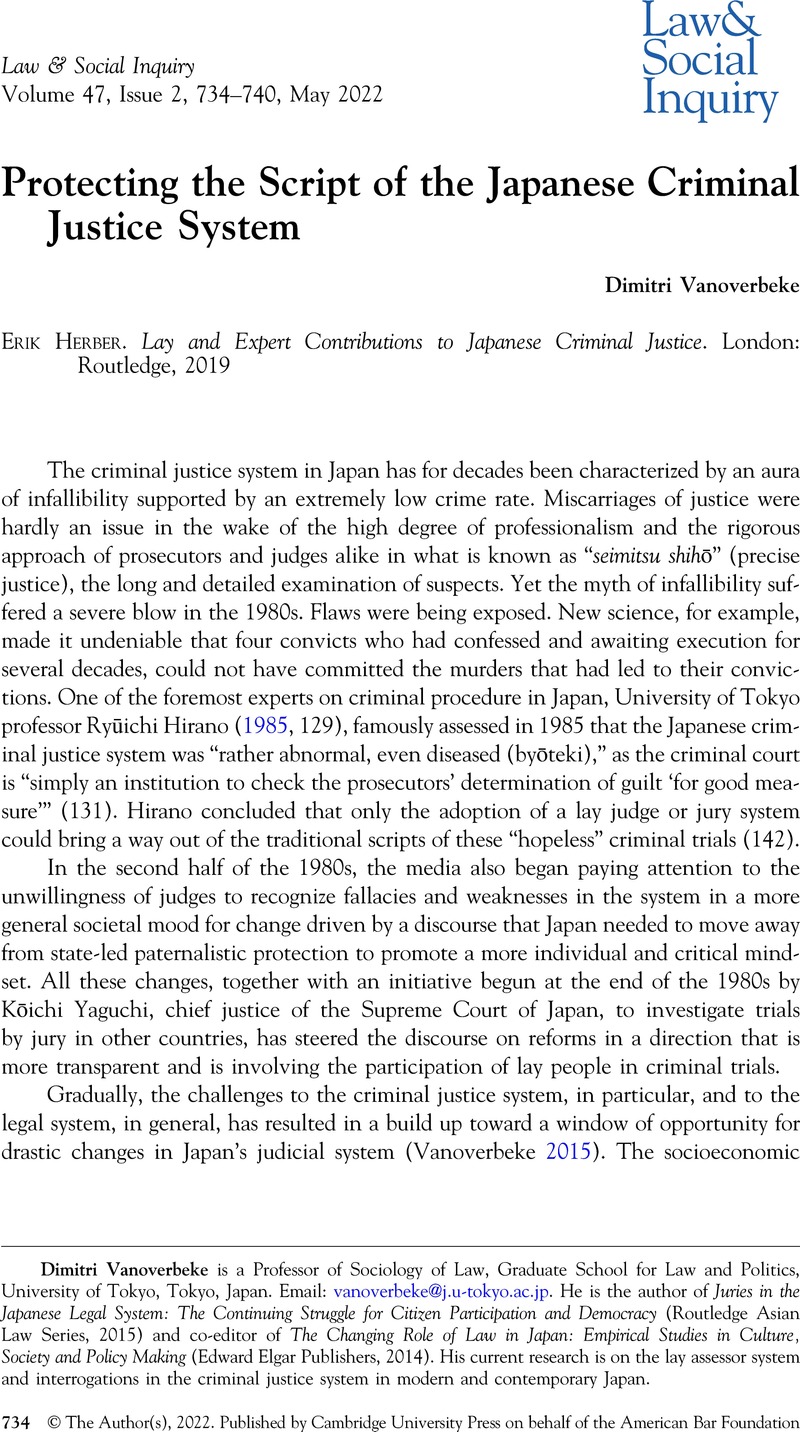No CrossRef data available.
Article contents
Protecting the Script of the Japanese Criminal Justice System
Published online by Cambridge University Press: 04 March 2022
Abstract
An abstract is not available for this content so a preview has been provided. Please use the Get access link above for information on how to access this content.

- Type
- International Book Essays
- Information
- Copyright
- © The Author(s), 2022. Published by Cambridge University Press on behalf of the American Bar Foundation
Footnotes
He is the author of Juries in the Japanese Legal System: The Continuing Struggle for Citizen Participation and Democracy (Routledge Asian Law Series, 2015) and co-editor of The Changing Role of Law in Japan: Empirical Studies in Culture, Society and Policy Making (Edward Elgar Publishers, 2014). His current research is on the lay assessor system and interrogations in the criminal justice system in modern and contemporary Japan.
References
REFERENCES
Ancel, Marc. 1987. Social Defense: The Future of Penal Reform. Translated by Wise, E. M.. New York: F. B. Rothman.Google Scholar
Foote, Daniel H. 2014. “Citizen Participation: Appraising the Saiban’in System.” Michigan State International Law Review 22: 755–75.Google Scholar
Foucault, Michel. 1978. Discipline and Punish. Translated by Sheridan, Alan. New York: Vintage.Google Scholar
Herber, Erik. 2019. Lay and Expert Contributions to Japanese Criminal Justice. London: Routledge.CrossRefGoogle Scholar
Hirano, Ryūichi. 1985. “Diagnosis of the Current Code of Criminal Procedure” [現代刑事訴訟法の診断]. In Collected Essays at the Occasion of the Celebration of Dr. Dandō [団藤重光博士古稀祝賀論文集], edited by Yasuharu Hiraba et al., 407–23. Vol. 4. Tokyo: Yūhikaku.Google Scholar
Hirano, Ryūichi. 1989. “Diagnosis of the Current Code of Criminal Procedure.” Translated by Daniel H. Foote. Law in Japan 25, no. 49: 129–42.Google Scholar
Johnson, David T., and Vanoverbeke, Dimitri. 2020. “The Limits of Change in Japanese Criminal Justice.” Zeitschrift für Japanisches Recht 25: 109–65.Google Scholar
Luhmann, Niklas. 1987. “Unity of the Legal System.” Autopoietic Law: A New Approach to Law and Society, edited by Teubner, Gunther, 12–35. Berlin: Walter de Gruyter.Google Scholar
Vanoverbeke, Dimitri, and Fukurai, Hiroshi. 2021. “Lay Participation in the Criminal Trial in Japan: A Decade of Activity and Its Sociopolitical Consequences.” Juries, Lay Judges, and Mixed Courts, edited by Sanja Kutnjak Ivković, Shari Seidman Diamond, Hans, Valerie P., and Marder, Nancy S., 69–87. Cambridge, UK: Cambridge University Press.CrossRefGoogle Scholar
Vanoverbeke, Dimitri. 2015. Juries in the Japanese Legal System: The Continuing Struggle for Citizen Participation and Democracy. London: Routledge.CrossRefGoogle Scholar
Vanoverbeke, Dimitri, Maesschalck, Jeroen, Nelken, David, and Parmentier, Stephan, eds. 2014. The Changing Role of Law in Japan: Empirical Studies in Culture, Society and Policy Making. Cheltenham, UK: Edward Elgar.CrossRefGoogle Scholar
Wilson, Matthew J. 2017. “Japan’s Lay Judge System: Impact on the Judiciary and Society.” In The Legal Process in Contemporary Japan: A Festschrift in Honor of Professor Setsuo Miyazawa’s 70th Birthday, edited by Ageishi, K., Ōtsuka, H., Musashi, K., and Hirayama, M., 369–84. Tokyo: Shinzansha.Google Scholar




